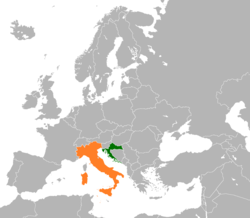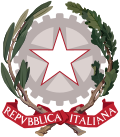Croatia–Italy relations
 From Wikipedia - Reading time: 10 min
From Wikipedia - Reading time: 10 min
 | |
Croatia |
Italy |
|---|---|
| Diplomatic mission | |
| Embassy of Croatia, Rome | Embassy of Italy, Zagreb |
The foreign relations between Croatia and Italy are commenced in 1992, following the dissolution of Yugoslavia and the independence of Croatia. Relations are warm and friendly with robust bilateral collaboration.[1][2] The two nations have strong connectivity through tourism, immigration, foreign aid, and economic mutualism.
Italian is an official language in Croatia's Istria County (Istrian Italians), while Molise Croats inhabit the Italian city of Campobasso. The close multiculturalism between Croatia and Italy is broadly popular and favored domestically. Croatia and Italy are close military allies, especially through their naval and coastal forces, with membership in NATO. They share a 370 nautical-mile maritime border over the Adriatic Sea, with a small 12 mile region of Slovenia separating them by land.
Both countries are members of the European Union and Council of Europe, sharing the same official currency, the euro (€). Croatia has an embassy in Rome and general consulates in Milan and Trieste while Italy maintains an embassy in Zagreb and a general consulate in Rijeka, among other cultural organizations.
History
[edit]The foreign relations between Croatia and Italy are commenced in 1992, following the dissolution of Yugoslavia and the independence of Croatia. Italy was a key partner to Croatia following its statehood, providing critical political and economic support during the 2000s.[3] In 2007, Italy's president Giorgio Napolitano strained diplomatic relations by referring to the Yugoslav communist Partisans’ expulsions of Italians during the end of World War II, as the "barbarism of the century" and being a result of “Slav bloodthirsty hatred and rage”. This led to Croatia and Slovenia condemning the comment.[4] Croatian president Stjepan Mesić accused Napoletano of historical revisionism but the nations' diplomats quickly resolved the matter in Rome.[4]
Italy supported Croatia's admission to the European Union in 2013. A diplomatic row emerged between the two states in 2019, after Antonio Tajani, the President of the European Parliament, commented "Long live Trieste, long live Italian Istria, long live Italian Dalmatia, long live Italian exiles".[5] Tajani later apologized to the Croatian government clarifying his comments were not intended to imply that the Istrian and Dalmatian regions of Croatia were a part of Italy.[6] In 2023, after a decade of strong economic activity, Italy became Croatia's most important trading partner with a 45% increase since 2021, according to Tajani.[2] That year, the two nations signed a tri-party agreement with Slovenia to ease immigration in Southeast Europe.[7] Italy helped return a rare and "extremely valuable" 14th-century religious cross to Croatia, after a private citizen inadvertently bought it during an auction in London.[8]
Diaspora
[edit]There are around 19,500 people of Italian descent living in Croatia. There are also around 6,000 Molise Croats in Italy. In addition, there are around 21,000 registered immigrant Croatian workers in Italy.[9] Italian is an officially-recognized language in Croatia, with the majority of its speakers living in Istria County. Dalmatian Italians historically constituted a significant population of Dalmatia. Italian is a popular foreign language in Croatia, with 14% of Croatians able to speak it well enough to have a conversation, according to Eurobarometer.[10]
Military cooperation
[edit]Croatia and Italy are close military allies, especially through their naval and coastal forces. Both are members of NATO, effectively establishing a defense pact between the two countries through Article 5. The Italian Air Force temporarily protected Croatian airspace in 2024 while the Croatian Air Force completed aircraft maintenance and completed a procurement of 12 new fighter jets from France.[11]
Trade
[edit]The two countries share multiple bilateral free-trade agreements. Croatia exports around 14% of their total annual export to Italy.[12] Trade between the two states totaled €8.64 billion in 2023, reaching an all-time high.[2]
Fishing
[edit]Croatia and Italy both maintain exclusive economic zones over the Adriatic Sea. Italy disputed the reach of Croatia's zone around the Italian part of the Adriatic in January 2008 claiming it violated an earlier agreement they made over "Ecological and Fisheries Protection Zones".[13] The two states mutually settled the dispute later that year.[13] This zone is supervised by the Croatian Navy, which intercepted two Italian ships in 2008 and 2021, seizing their illegal fish, and escorting them back to Italian waters.[14][15]
Diplomatic missions
[edit]
Croatia has an embassy in Rome, general consulates in Milan and Trieste, and consulates in Bari, Florence, Naples, and Padua.[16] Italy has an embassy in Zagreb, general consulate in Rijeka, Vice Consulate in Buje, Pula and Split, as well as Italian Cultural Institute and Foreign Trade Institute in Zagreb.[17]
Sister cities
[edit]Croatia and Italy share a large number of sister cities between themselves.[18][19] Many of these cities have Croatian and Italian-language versions of their name due to historic cultural diffusion.


 Biograd and
Biograd and  Porto San Giorgio
Porto San Giorgio Bjelovar and
Bjelovar and  Ascoli Piceno /
Ascoli Piceno /  Rubiera
Rubiera Crikvenica and
Crikvenica and  Verbania
Verbania Dubrovnik and
Dubrovnik and  Venezia /
Venezia /  Ragusa /
Ragusa /  Ravenna
Ravenna Karlovac and
Karlovac and  Alessandria
Alessandria Križevci and
Križevci and  Reana del Rojale
Reana del Rojale Labin and
Labin and  Carbonia /
Carbonia /  Manzano /
Manzano /  Sospirolo
Sospirolo Lipik and
Lipik and  Abano Terme
Abano Terme Matulji and
Matulji and  Castel San Pietro Terme
Castel San Pietro Terme Medulin and
Medulin and  Montecarotto /
Montecarotto /  Porto Tolle
Porto Tolle Novigrad and
Novigrad and  Sacile
Sacile Omiš and
Omiš and  San Felice del Molise
San Felice del Molise Opatija and
Opatija and  Carmagnola /
Carmagnola /  Castel San Pietro Terme
Castel San Pietro Terme Osijek and
Osijek and  Vicenza
Vicenza Pag and
Pag and  Carbonera /
Carbonera /  Zanè
Zanè Poreč and
Poreč and  Massa Lombarda /
Massa Lombarda /  Monselice /
Monselice /  Segrate
Segrate Pula and
Pula and  Imola /
Imola /  Verona
Verona Rijeka and
Rijeka and  Este /
Este /  Faenza /
Faenza /  Genoa /
Genoa /  Trieste
Trieste Samobor and
Samobor and  Parabiago
Parabiago Šibenik and
Šibenik and  Civitanova Marche /
Civitanova Marche /  Muggia /
Muggia /  San Benedetto del Tronto
San Benedetto del Tronto Slunj and
Slunj and  Castel San Giovanni
Castel San Giovanni Split and
Split and  Ancona
Ancona Tisno and
Tisno and  Bucine
Bucine Trogir and
Trogir and  Montesilvano /
Montesilvano /  Porto Sant'Elpidio /
Porto Sant'Elpidio /  Tione di Trento
Tione di Trento Varaždin and
Varaždin and  Montale
Montale Vinkovci and
Vinkovci and  Camponogara
Camponogara Zadar and
Zadar and  Ancona /
Ancona /  Padua /
Padua /  Reggio Emilia
Reggio Emilia Zagreb and
Zagreb and  Bologna /
Bologna /  Molise
Molise
See also
[edit]- Foreign relations of Croatia
- Foreign relations of Italy
- Italian language in Croatia
- Croats of Italy
- Italians of Croatia
- Italy–Yugoslavia relations
References
[edit]- ^ "Croatia in Europe Through the Ages: Croatian-Italian relations". Croatian Ministry of Foreign and European Affairs. 22 December 2023. Retrieved 22 December 2023.
- ^ a b c "Croatia-Italy economic cooperation at all-time high: Italy Croatia's number one trade partner". template.gov.hr. Retrieved 2023-12-24.
- ^ "Italy-Croatia: concert in Zagreb to mark the anniversary of diplomatic relations – Ministero degli Affari Esteri e della Cooperazione Internazionale". www.esteri.it. Retrieved 2023-12-24.
- ^ a b Traynor, Ian (2007-02-13). "Italy and Croatia reopen old war wounds". The Guardian. ISSN 0261-3077. Retrieved 2023-12-24.
- ^ Barigazzi, Jacopo (2019-02-11). "Slovenian, Croatian leaders accuse Tajani of 'historical revisionism'". POLITICO. Retrieved 2023-12-24.
- ^ "Cerarja Tajanijevo opravičilo ni prepričalo. Tajanija k odstopu poziva tudi NSi". rtvslo.si (in Slovenian). 2019-02-12. Retrieved 2019-02-12.
- ^ Radosavljevic, Zoran (2023-11-03). "Italy, Slovenia, Croatia step up cooperation on migrants". www.euractiv.com. Retrieved 2023-12-24.
- ^ "14th century processional cross returned to Croatia after 50 years". template.gov.hr. Retrieved 2023-12-24.
- ^ "Archived copy". Archived from the original on February 8, 2012. Retrieved August 7, 2014.
{{cite web}}: CS1 maint: archived copy as title (link) - ^ Directorate General for Education and Culture; Directorate General Press and Communication (2006). Europeans and their Languages (PDF). Archived from the original (PDF) on 2016-04-14. Retrieved 2010-03-11.
- ^ Drazen (2024-12-10). "Notification: from 1st December Italian Eurofighters and Hungarian Gripens will temporarily perform Air Policing". MORH. Retrieved 2025-06-18.
- ^ "Najvažniji partner: Porast industrijskih narudžbi u Italiji otvara mogućnost rasta hrvatskog izvoza". www.index.hr.
- ^ a b "Croatia's Mesic suggests modification of proposed fishing zone likely". SETimes.com. 2008-01-01. Retrieved 2010-06-11.
- ^ Croatia seizes Italian boat days after fishery zone comes into force
- ^ Karakaš Jakubin, Hajdi (27 May 2021). "Talijanski ribari uhićeni dok su ilegalno lovili ribu nadomak Splita, prijeti im velika kazna" [Italian fishermen arrested while illegally fishing near Split face a heavy fine]. Jutarnji list (in Croatian). Retrieved 9 January 2023.
- ^ "MVEP • Veleposlanstva RH u svijetu • Italija, Rim". www.mvep.hr.
- ^ "MVEP • Veleposlanstva stranih država u RH • Italija, Zagreb". www.mvep.hr.
- ^ "Gradovi prijatelji". bjelovar.hr (in Croatian). Bjelovar. Retrieved 2019-10-28.
- ^ "Gradovi prijatelji". dubrovnik.hr (in Croatian). Dubrovnik. Retrieved 2019-10-28.
 KSF
KSF
